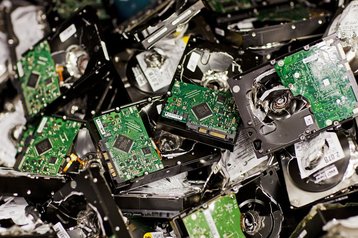My first thought on hearing that Google now has six data centers that produce no landfill waste was: well done - that’s an aspect of green data centers that not everyone is aware of. Then I thought - why not send the whole data center to the landfill?
First though, how much waste does a data center produce, anyway? Google’s blog, by sustainability manager Rachel Futrell, doesn’t give a lot of detail, but data centers trade in virtual commodities: storage, processing and communications. They consume real electricity, as well as real water in their cooling systems. But most of their other physical needs will be similar to office buildings or warehouses, and present a similar (fairly minor) problem in disposal.
So data centers going zero-waste comes into the category of the tech industry leading on a general issue - because it can. The high margins in the sector mean that data centers can afford to invest in cleaner supply chains than most, just as they can invest in cleaner energy. So go, data centers!
Easier for Google?
Reducing landfill waste is important. At 2,200 acres, the Fresh Kills landfill site on Staten Island, New York, was at one time, the largest human structure ever built. It was opened as a temporary measure in 1947, became New York’s main dump, and is now been redeveloped.
Humanity produces a huge amount of waste and, regardless of their location, data centers can help with that. Remote locations in the countryside shouldn’t be spoiling the view. And urban data centers may find that landfill space is a shrinking resource. Singapore, where one of Google’s zero-trash data centers is located, is a small island and has said it will actually run of landfill space in the next fifteen to twenty years.
Data centers obviously produce one category of waste in greater quantities than other businesses: e-waste. Servers have a limited lifespan in a data center, if only because newer generations are so much more powerful and energy efficient, that it is cheaper to replace functional equipment, for the savings on the electricity bill, and the ability to do more in the same space or less.
Data centers also dispose of lots of functional hard drives: in a recent public video tour of its data centers, Google made its disk destroyer a star: the machine reduces old hard drives to shards and splinters, to make sure that the data stored on them never gets into the wrong hands.
Destroying hardware should take account of the embodied energy in the equipment, as well as the environmental impact of disposing of it.
But the low profile of e-waste has resulted in poor regulation and a lot of bad practices. A recent report used GPS tracking to find that 40 percent of firms claiming to recycle e-waste in the US are complete shams, simply shipping the waste to landfills abroad, some of them in China. The situation in Europe may be better, as the region has strong e-waste policies.
Google should make sure it’s not dealing with e-waste cowboys. And raising the profile of the issue, ought to make it easier for the rest of us to make sure we get proper recycling,
Finally though, some years back Microsoft came up with the idea of shipping the whole data center to landfill. Back in 2010, the company’s manager of data center research Christian Belady suggested that these landfill contains a lot of rotting organic matter. That makes methane which can be harnessed and used to power a data center.
In 2014, the company actually went ahead and built a prototype HPC cluster, at a water reclamation plant, powered by fuel cells running on bio-methane.
Google’s step is important, but there’s always more that can be done.
A version of this story appeared on Green Data Center News



